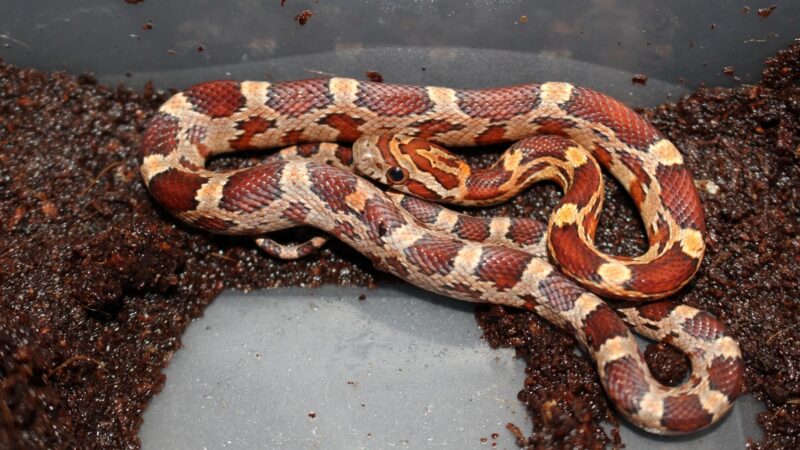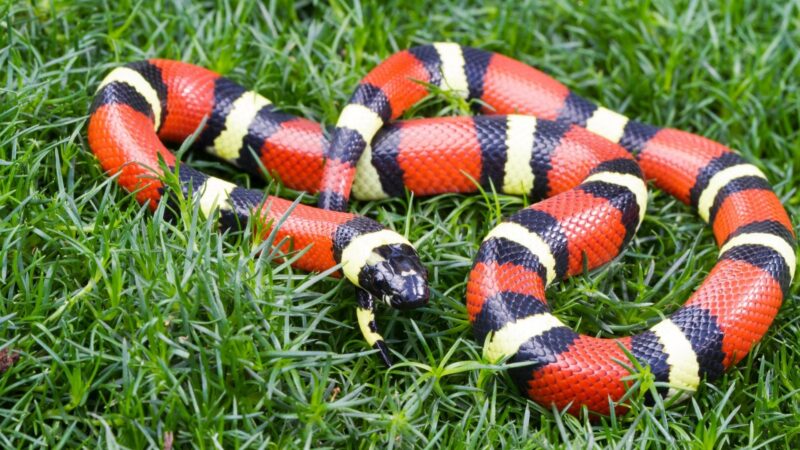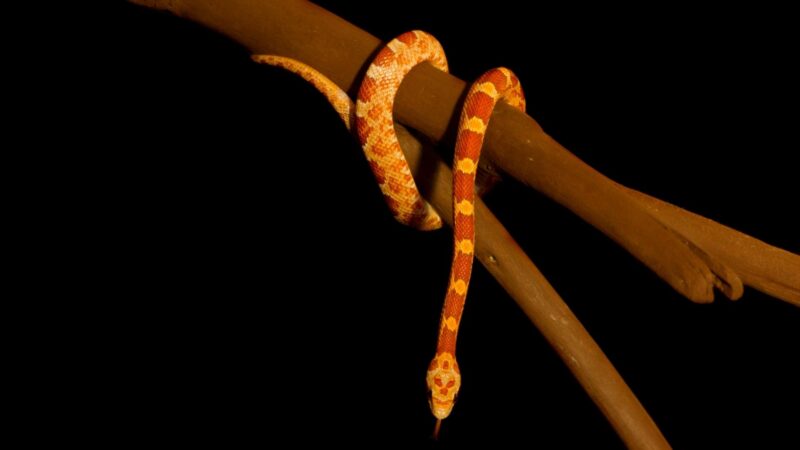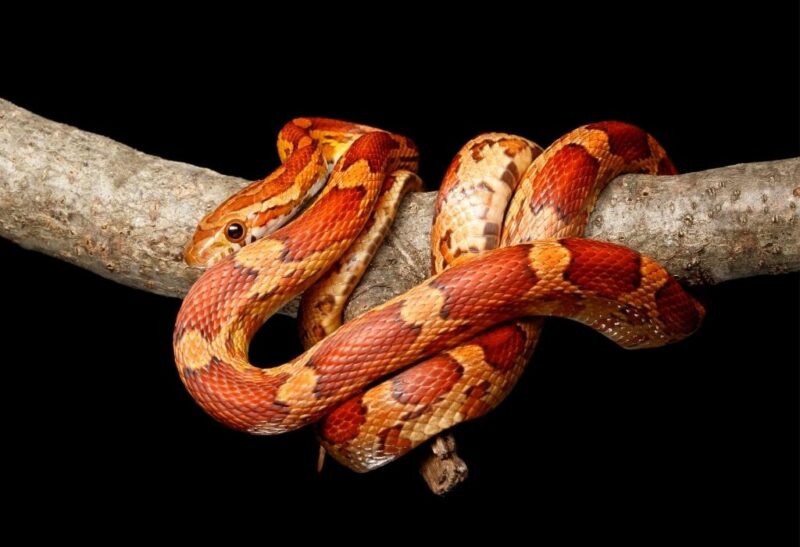Snakes are often associated with dangerous encounters and the cause of wildlife-related deaths but what people don’t realize is that safe breeds, such as the corn snake and milk snake, make good companions.
However, people may find it difficult in differentiating between the two and choosing the best snake to adopt since they’re both great starter choices for beginner snake owners.
Corn snakes and milk snakes are similar in size and weight, lifespan, natural habitats, and personality. However, milk snakes come in brighter and more vibrant colors than corn snakes. Milk snakes are picky eaters while corn snakes can eat anything.
Read more if you want to find out about their distinguishing characteristics, differences, and similarities, which breed is considered venomous, and how to take good care of them!
Table of Contents
Corn Snake | Identification

Also referred to as red rat snakes, corn snakes are constrictors and can swallow prey alive. In the wild, they live in meadowlands, wooded groves and lots, barns, rocky hillsides, and open areas. They’re often mistaken for copperheads which are known for biting.
- Scientific Name: Pantherophis guttatus
- Appearance: Slender with orange or brick-yellow patterns and red blotches with black outlines on their backs. Bellies have alternating black and white marks similar to a checkerboard pattern.
- Lifespan: 6 to 8 years (wild), Up to 23 years (captivity)
- Size: 2 to 5 feet
- Weight: 2 to 3.3 pounds
- Diet: Lizards, tree frogs, mice, bats, birds, and rats
- Place Of Origin: Eastern United States
- Characteristics: Nocturnal in cold regions and diurnal in warm regions. They’re shy, reclusive, and solitary unless searching for prey. They’re also skilled climbers that are able to scale trees.
Milk Snake | Identification

The term milk snakes are derived from a debunked myth that claims they can suck milk from cows. Milk snakes are constrictors that are commonly found in Nearctic regions, usually in forest edges, grasslands, rocky hillsides, farmlands, and suburban areas.
- Scientific Name: Lampropeltis triangulum
- Appearance: Body color can range from varying shades of gray and brown, with brown to red blotches that are edged with black down its back or sides. Its belly is black and white with a checkered pattern.
- Lifespan: 3 to 4 years (wild), Up to 21 years (captivity)
- Size: 1 to 5.7 feet
- Weight: 1.3 ounces to 3 pounds
- Diet: Rats, voles, mice, bird and bird eggs, lizards, snake and snake eggs
- Place Of Origin: Central America
- Characteristics: Solitary and nocturnal species who are secretive and like to hide during the day unless looking for prey. They group with other members during hibernation.
What Is the Difference Between Corn Snakes and Milk Snakes?

- Appearance. Despite both snakes coming in varying shades of red, orange, and yellow and having similar checkerboard and patterned scales, milk snakes are brighter and more vibrant in appearance than corn snakes.
- Feeding Habits. Although both snakes are constrictors who suffocate their prey by coiling their bodies around them before eating, milk snakes are more difficult to feed as they can be picky eaters, preferring to eat mice and rats. Corn snakes, on the other hand, eat virtually anything.
What Are the Distinct Similarities Between Corn Snakes and Milk Snakes?
- Size and Weight. Although female corn snakes are thicker in width than male corn snakes and that milk snakes can be relatively bulky, both corn snakes and milk snakes don’t go beyond 6 feet in length and 3 pounds in weight.
- Lifespan. Both snakes last up to a little over 20 years in captivity, assuming they’re well taken care of. In the wild, they live up to a considerably less amount of time, with corn snakes having up to 8 years and milk snakes having up to 4 years.
- Natural Habitats. Preferring to live in forested terrestrial biomes, both snakes can live virtually anywhere, even in agricultural or suburban areas with human presence. In captivity, both snakes are ideally placed in glass aquariums that resemble their natural habitats (e.g. adding leaves and pieces of wood).
- Personality. What makes both snakes ideal pets is that they’re both friendly to humans and are not known to have aggressive tendencies. However, both snakes can get stressed, especially when they’re young.
They may nip owners, but it won’t hurt as much since they have small teeth. Most of the time, they’re easy to handle and can get used to human presence fast.
Which Are Venomous: Corn Snakes or Milk Snakes?

Both corn snakes and milk snakes are non-venomous and generally docile snake species, which is why they’re great to keep as pets, especially for beginners. Even if they tend to bite when they’re stressed, they won’t hurt, and there would be no venom to worry about.
When feeling threatened, corn snakes will strike while vibrating their tails, which is why it’s best to leave them alone when they’re in the wild. Milk snakes will also display the same behavior but are more prone to biting.
However, even wild corn snakes and milk snakes can easily become tame in captivity.
How to Take Good Care of Corn Snakes?
Tip 1: Set up a glass aquarium with a secure top. Place a water bowl that’s big enough for them to submerge in and also drink from.
Tip 2: Add a heating source (i.e., a heating pad), a thermometer to monitor the aquarium’s temperatures, and a substrate, preferably aspen beddings, where they can burrow into.
Tip 3: Proper monitoring of the aquarium conditions should be done regularly. Remove any urine or fecal matter and keep the temperature on the cool side of the aquarium at 75°F.
Tip 4: Feed corn snakes with pre-killed mice that have been frozen and thawed. It’s recommended to feed them in a separate enclosure in the aquarium, so they don’t accidentally ingest the substrate.
How to Handle a Corn Snake?
When holding a corn snake, make sure you wash your hands and allow it to freely explore around you. Don’t place them on surfaces where you eat, such as at dining tables.
Avoid handling them when they’re in the middle of shedding their skin, which you can identify if they have a bluish hue in their eyes. Don’t pick them up 48 hours after they’ve just finished eating either as they might vomit out the contents.
How to Take Good Care of Milk Snakes?
Tip 1: Set up a large enough wooden vivarium with two enclosures that offer a cold and warm region so that the snake can regulate its body temperature easier.
Tip 2: Add a thermometer and a substrate they can burrow into. Again, aspen beddings are always a good choice.
Tip 3: Milk snakes don’t eat very often, only about every 7 to 10 days. They also eat mice and rats. Make sure the snake has a water source nearby either for drinking or immersing themselves.
Tip 4: Properly monitor the aquarium conditions regularly. Clean up dirt and other wastes and refill water when necessary.
How to Handle a Milk Snake?
Similar to handling corn snakes, make sure your hands are clean before holding them. Avoid making fast, unnecessary movements that may agitate the snake.
If they’re particularly nippy or it’s the first time you’re going to handle them, hold out your hand first and let them come to you naturally. Don’t be frightened by their wobbly movements, as milk snakes normally do that.
How to Know if the Snake is Sick?
If snakes are not feeling well they will usually stop eating. They will also be regurgitating food, become listless, have wrinkled skin, or behave unnaturally.
One telltale sign is that they are discharging through their noses, or you’re able to hear them breathe or whistle.
Common causes of snake diseases are worms, protozoans, and mites. They’re also prone to bacterial infections if they have open bite wounds made by live prey that is dirtied due to the substrate and other bacteria in the aquarium.
Snakes can also accidentally burn themselves in the heating pads, so make sure you properly regulate their temperature.
Summary
Corn snakes and milk snakes are great to keep as pets thanks to their friendly and docile natures. They don’t differ much aside from appearance and feeding habits, so it all boils down to whatever snake speaks to you the most when choosing.
When taking care of snakes, make sure they have adequately-sized containers with a heating and water source, thermometer, substrate, and mice and rats for food.
List of Sources
Corn snake. Smithsonian’s National Zoo & Conservation Biology Institute.
Isberg, T. (2002). Lampropeltis Triangulum. Animal Diversity Web.
Resmer, K. (1999). Pantherophis Guttatus. Animal Diversity Web.
Morales, C. Snake World. University of Texas Rio Grande Valley.
Fact Sheets – Snakes. San José State University.
